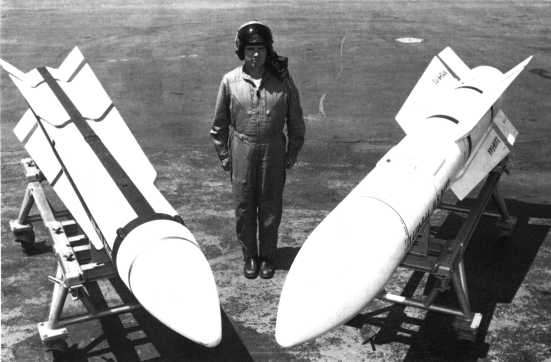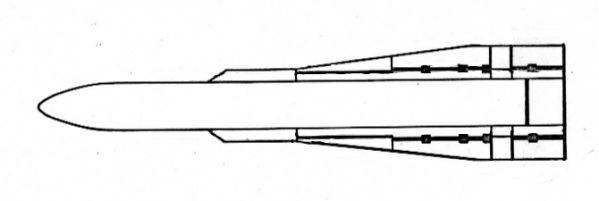Hughes GAR-9/AIM-47 Falcon
In 1957 Hughes was developing a weapon system as part of the USAF's LRI-X requirement for a Mach 3 interceptor. The system was composed of the XY-1 fire control system and the GAR-X air-to-air missile. As originally envisaged, the GAR-X would have used interchangeable HE or nuclear warheads, with a range of between 15 and 25 miles (25-40 km). In April of 1958 the systems, which were by then assigned to the winning LRI-X design, were assigned the designations AN/ASG-18 and GAR-9. The winning LRI-X design was, of course, the North American F-108 Rapier. At one point in 1957 an XF-103 was considered for use by Hughes for weapon system trials for systems associated with the LRI-X program. When the F-108 program was cancelled on 23 September 1959, it was determined that the AN/ASG-18 and GAR-9 would continue to be developed.
The XGAR-9, redesignated XAIM-47A in 1963, was a very large missile intended primarily for long-range interception of incoming Soviet bombers. Boasting a range in excess of 160 km (100 mi), the GAR-9 utilized SARH guidance, with a seeker head capable of locking on to a 9.3 m2 (100 sq.ft.) target at a range of 116 km (63 nm). The missile would fly early portions of its flight path using an autopilot programmed using pre-launch target position and heading data. Early problems with the development of the SARH seeker led to the development of a dual-mode SARH/IR seeker head. This was ultimately abandoned when it was determined that the missile would increase in diameter by 2 inches (and weigh 180 more pounds (82 kg)), necessitating a redesign of the F-108's entire weapon bay! Power was intended to be provided by an Aerojet-General XM59 solid rocket, giving a speed of Mach 6. Ultimately, problems with this motor led to its being replaced with the Lockheed XSR13-LP-1 solid rocket motor (a Lockheed-designed storable liquid-fuel motor was briefly considered), which offered less power and a slower Mach 4 top speed. Initially, National Laboratories began development of the 0.25 kiloton W-42 nuclear warhead for use with the GAR-9. This was cancelled in 1958. Other attempts to develop nuclear warheads for the GAR-9 also bore no fruit, and by mid-1959 the weapon had gained a 45 kg (100 lb) HE warhead with proximity fuzing.
 |
| Photo: Hughes |
| Left: XAIM-47A; Right: XAIM-54A |
After the aforementioned plans to test the system using an XF-103 came to nothing, Hughes eventually settled on using a modified B-58 Hustler Mach 2 bomber. The aircraft gained a greatly modified nose housing the AN/ASG-18, a new ventral pod containing one GAR-9 missile, and other minor modifications. The aircraft, s/n 55-665, was nicknamed "Snoopy" thanks to its new proboscis. Ground launches of the GAR-9 began in August 1961, with air launches being undertaken from Snoopy beginning in May 1962. In 1960 Lockheed began developing what would become the YF-12A interceptor derivative of the CIA's A-12 reconnaissance aircraft. As the F-108 had been cancelled, Hughes joined with Lockheed and the weapon system which had once belonged to the LRI-X found a new home in a Lockheed Blackbird. The YF-12A featured four weapon bays, but the forward bay on the starboard side was used for excess electronics equipment associated with the fire control system. Eventually, seven guided launches would be attempted from the YF-12A prototypes, resulting in six kills. The lone miss was attributed to a missile power failure.
Production AIM-47s would likely have been of the compressed-carriage AIM-47B variant, incorporating folding fins to fit inside redesigned weapon bays on the modified F-12B. Although the F-12B was destined never to see production, the AIM-47 and AN/ASG-18 were to leave a lasting legacy. The AIM-47 served as the basis for the AIM-54 Phoenix AAM under design for the U.S. Navy, while the AN/ASG-18 was also a starting point for the associated AN/AWG-9 radar. The AIM-47 program ended with around 80 missiles having been produced.
 |
| Drawing: via Sean O'Connor |
| AIM-47B * |
*Note: Original drawing was superimposed over a drawing of AIM-54C, whose sketch lines have been edited out in the image shown here. Click here for original drawing.
An anti-radar version, the AGM-76A, was briefly evaluated. The AIM-47 was also briefly considered as a self-defense weapon for the B-70 Valkyrie bomber.
Specifications
Note: Data given by several sources show slight variations. Figures given below may therefore be inaccurate!
Data for XAIM-47A, AIM-47B:
| XAIM-47A | AIM-47B | |
|---|---|---|
| Length | 3.82 m (12 ft 6.5 in) | |
| Wingspan | 83.8 cm (33 in) | |
| Diameter | 34.3 cm (13.5 in) | 33.0 cm (13.0 in) |
| Weight | 371 kg (818 lb) | 363 kg (800 lb) |
| Speed | Mach 4 | |
| Range | > 160 km (100 miles) | |
| Propulsion | Lockheed XSR13-LP-1 solid-fueled rocket | |
| Warhead | 45 kg (100 lb) high-explosive | |
Main Sources
[1] Dennis R. Jenkins & Tony R. Landis: "Valkyrie - North American's Mach 3 Superbomber", Specialty Press, 2004
[2] Tony R. Landis and Dennis R. Jenkins: "Lockheed Blackbirds", Specialty Press, 2004
[3] "A Potential SR-71 Mission: Phase 1-Preliminary Study", declassified SENIOR CROWN program document from 1976
Back to Current Designations Of U.S. Unmanned Military Aerospace Vehicles
Back to Directory of U.S. Military Rockets and Missiles
Last Updated: 16 December 2004